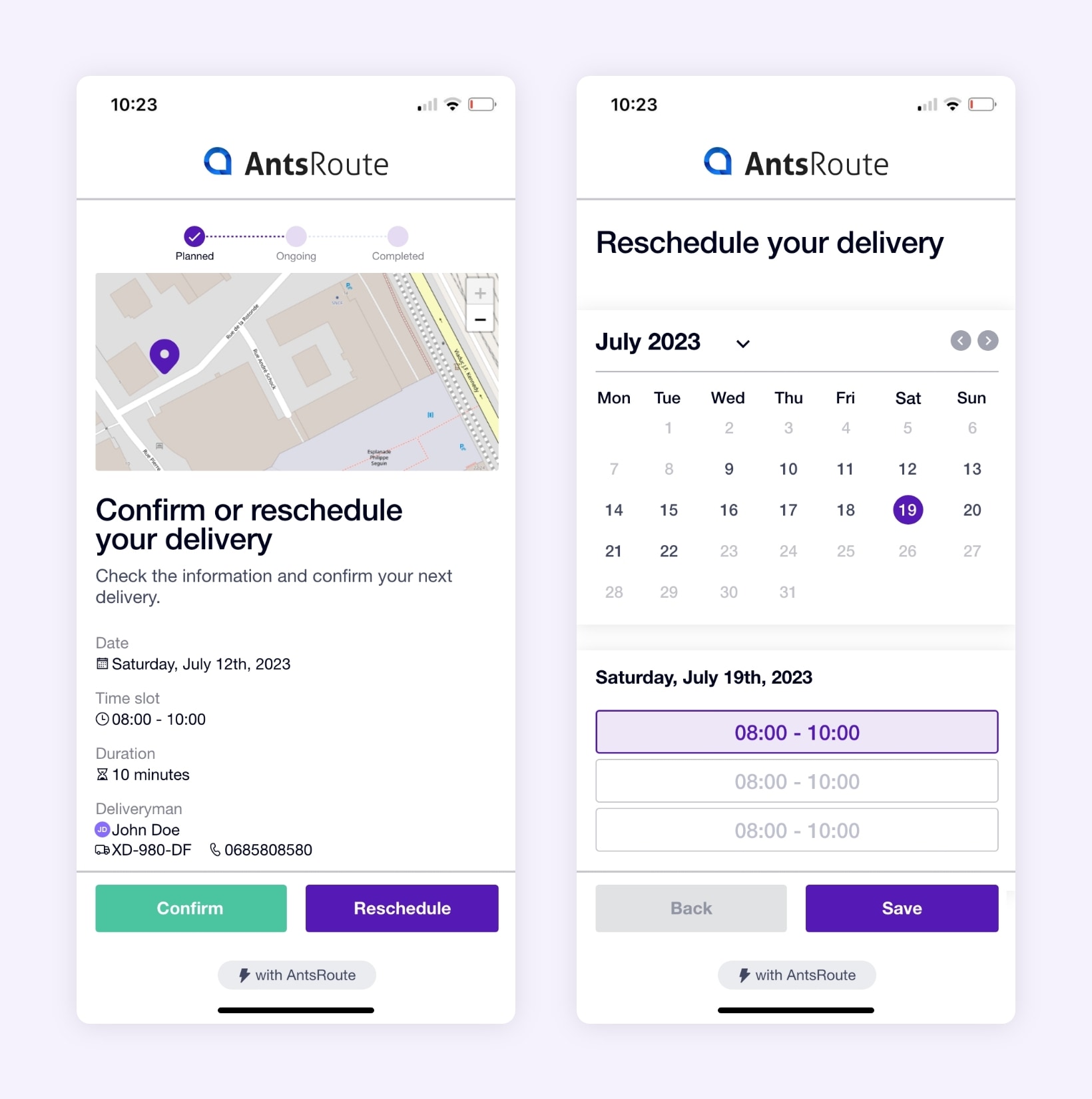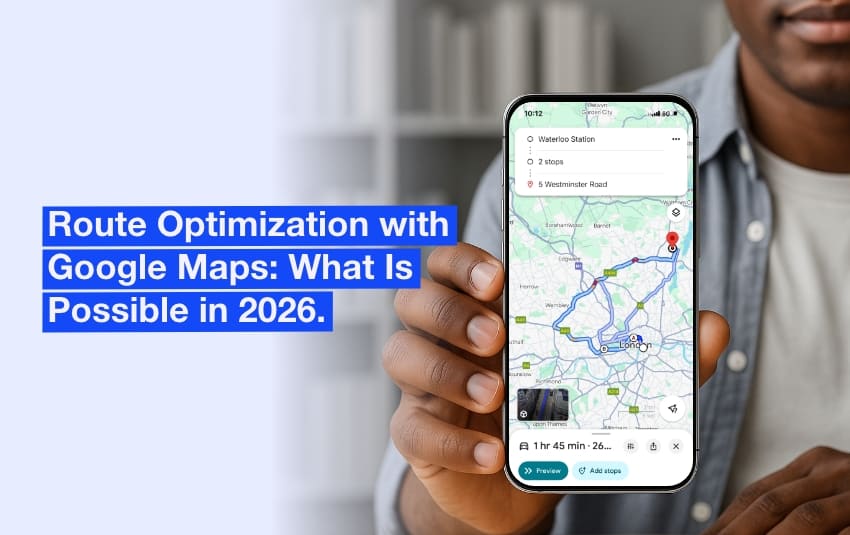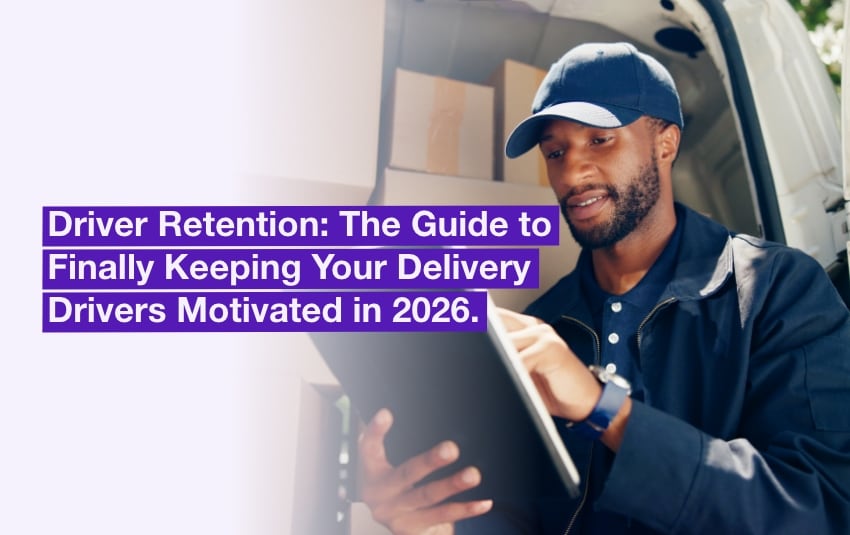How does the use of an application enable the loyalty of delivery drivers?

Transport companies are faced with a persistent shortage of delivery drivers, despite many permanent positions on offer. To deal with this, they are looking at all the solutions available to them, starting with route optimisation applications.
Against all odds, these planning software applications represent a preferred solution for improving drivers’ working conditions and reducing their stress levels.
Thanks to such applications, operations managers can create more accurate routes, while drivers can be sure of receiving the right information at the right time to carry out their route successfully.
Table of contents
- 7 reasons to buy an application for your drivers
- The shortage of delivery drivers is here to stay
- You build realistic and balanced routes
- The mobile app for delivery drivers and couriers adapts to the type of vehicle used
- The route is reordered in real time
- The application summarises all the information about customers and deliveries
- Route optimisation app simplifies exchanges with end customers
- Digitisation of delivery documents eases administrative management
- Give your delivery drivers a free app: is it a good idea or not?
Mobile applications make life easier for delivery drivers. These tools enable realistic and balanced route planning. For transport companies, this is a guarantee of employee loyalty.
7 reasons to buy an application for your drivers
1. The shortage of delivery drivers is here to stay
The delivery and road haulage sectors are currently suffering from a serious lack of attractiveness. Persistent clichés cling to these jobs: long working hours, stress, work risks, low pay, and so on. And the health crisis hasn’t helped!
In its 2020 report, the Observatoire Prospectif des Transports et de la Logistique (OPTL) lists 42,230 vacancies registered with France Travail (English: France Work), previously Pôle emploi, for positions in “short-distance driving and delivery routes”. It is an increase of 8% compare to the previous year.
But the most revealing figure for this lack of attractiveness is the proportion of recruitments judged to be difficult. Operations managers found it difficult to recruit 60% of drivers and short-haul delivery staff. The figure was even 73% for lorry drivers!
The result: while business is growing, boosted in particular by the explosion in e-commerce, companies are not managing to recruit enough drivers to meet demand.
Some transport companies are forced to refuse contracts or postpone delivery dates, at the risk of upsetting their customers.
To avoid such situations, most companies try to implement strategies to prevent problems and build loyalty among delivery drivers. Improving the level of driver satisfaction and strengthening the bond with them is therefore now one of the missions of the logistics manager.
2. You build realistic and balanced routes
The routes that are considered unfeasible or unrealistic are among the most common reasons for dissatisfaction. The advantage of online route optimisation software is that it calculates the best route, taking into account a number of constraints:
- Working hours and obligatory rest periods for each driver.
- Departure or parking location of each driver.
- Volume and maximum loading capacity of each vehicle.
- Customer reception times and closing days.
- Immobilisation of vehicles for preventive maintenance operations.Time required to deliver the goods to the customer, including waiting times before loading or unloading at certain customer sites, etc.
By taking into account the many constraints inherent to the business, you limit the risk of unforeseen events, and therefore of unplanned overtime at the end of the route.
This is an essential step in relieving the pressure on drivers’ shoulders, and gradually re-establishing trust and communication…

The creation of realistic and balanced routes on AntsRoute.
3. The mobile app for delivery drivers and couriers adapts to the type of vehicle used
All route optimisation software works in connection with navigation applications such as Waze or Google Maps. The advantage of a route-planning application like AntsRoute is that you can set the precise parameters for the type of vehicle assigned to each driver: heavy goods vehicle (HGV), refrigerated lorry, light commercial vehicle, scooter, natural gas vehicle, electric car or bicycle, etc.
From the AntsRoute interface, the route plans are then created according to this information. For example, if you choose the “HGV” type, certain routes are modified to take account of traffic restrictions or the height of the vehicle (tunnel, bridge, etc.).
Similarly, you can set the maximum battery life of an electric vehicle. The application then calculates the optimum route based on the location of the charging stations.

AntsRoute adapts to the type of vehicle.
4. The route is reordered in real time
By extracting data from GPS applications such as Google Maps or Waze, your delivery drivers and couriers also benefit from real-time route updates. The application, which works on any mobile device, tells the driver his estimated time of arrival, with the number of minutes in advance or late in relation to the planned arrival time.
In the event of unexpected events, delays or traffic problems, the driver is automatically alerted, and his route is recalculated accordingly. If, for example, you ask a driver to make an extra stop to pick-up a parcel, the route is updated in real time on his smartphone, which also works as his GPS and route map.

The mobile application makes life easier for delivery drivers.
5. The application summarises all the information about customers and deliveries
Keeping your drivers loyal means improving in-house communication wherever possible. Transmitting useful information to drivers helps them feel involved and in control of the situation.
The objective of a route optimisation app is precisely to provide each operator with all the relevant data at any given moment. By logging on to the mobile application, drivers should be able to get answers to their main questions in the blink of an eye. Where should I load packages? How many stops should I do during my route? Which truck should I use? What’s the best route for delivering my customers?
In practical terms, with the AntsRoute app, drivers can view all the relevant information about their delivery route in real time:
- List of customers to be delivered, with their address and contact details.
- Button to call the customer without having to dial the number.
- Data to facilitate deliveries: closing days or times, comments on accessibility, who to contact, where to drop off parcels, door code, etc.
Thanks to this precise, concise overview of his route, there’s no longer any need to enter the various addresses one by one into his GPS. The driver has as much information as possible to ensure that his deliveries are successful at the first presentation, and to limit no-shows that are as time-consuming as they are stressful. In the event of a difficult delivery, he also feels less helpless when dealing with the customer, since he has more data to “clear up” the complaint beforehand.

The AntsRoute mobile application gives access to all the information about deliveries.
6. Route optimisation app simplifies exchanges with end customers
The use of a mobile application also improves exchanges, and therefore the relationship between the delivery driver and the end customer. These apps make it possible to communicate a great deal of information to the customer to be delivered, quickly and without the risk of missing data:
- Confirmation of delivery day and slot by email or text message.
- Reminder the day before delivery.
- Automated transmission of estimated time of arrival (ETA).
- Warning message in the event of a breakdown or traffic disruption.
- For multi-stop routes, notification when the driver leaves the previous customer, etc.
Informed and reassured, end customers can more easily organise themselves to receive their parcels on first presentation. In the event of a problem, they will also be less tempted to blame the driver, as the “bad news” will have been delivered beforehand…

Delivery rescheduling link sent with AntsRoute.
7. Digitisation of delivery documents eases administrative management
The last, but not least, reason for adopting a route optimisation application like AntsRoute is to eliminate paperwork. This is a crucial argument, given the amount of red tape involved in route management that some logistics professionals find daunting.
All the driver has to do, for example, is tap on the screen of his smartphone or tablet to find his route plan and delivery notes online in the mobile application. If the operations manager so wishes, he can also attach various documents relating to the route in electronic format (order forms, invoices, etc.).
Finally, the electronic signature and digitisation of proof of delivery are highly effective in preventing disputes and facilitating their handling. To certify the condition of parcels on arrival, the driver can, for example, take photos of them. This is an invaluable way of dealing with customers who are not always acting in good faith…
Similarly, if the customer is absent, the delivery driver can capture photos of the message displayed on the door, or enter a few words in the application to explain why the delivery failed.
Finally, this paperless proof of delivery eliminates the risk of delivery documents being lost or stolen.

Using a mobile application for delivery drivers simplifies your administrative management.
Give your delivery drivers a free app: is it a good idea or not?
If you decide to equip your delivery drivers with a mobile application, you’ll find that there are several free solutions, such as Google Maps or Waze. Particularly popular, these applications offer many advantages, but they also have some potential drawbacks.
To help you understand better, here’s an overview of the advantages and disadvantages of these free applications to consider when making your choice.
The advantages of free applications
- The cost: The most obvious advantage of this type of application is undoubtedly its cost. If you have a limited budget, using a free tool can be a very attractive option for your company.
- The performance: Some free applications can offer functions similar to those of paid apps. For example, the Google Maps application can be used to find the quickest route and navigate easily between two addresses.
- The ease of use: The free applications are easy to use, as they often offer fewer functions. This ease of use saves you time and reduces the cost of training your drivers.

The advantages and disadvantages of a free mobile application for delivery drivers.
The disadvantages of free applications
- Limited number of functions: Free applications are generally less comprehensive than paid applications. Features that require powerful algorithms are very rarely made available free of charge to delivery drivers. In addition, these tools can limit the number of deliveries you can make on a daily basis. For example, Google Maps can tell you the best route between two stops, but unlike a paid route optimisation application such as AntsRoute, the tool cannot optimise a route made up of ten or more deliveries. In short, if you have a heavy workload, using a free application is not really appropriate.
- Lack of availability: Unlike paid solutions, which commit to an availability rate often over 99%, free applications often have more frequent bugs. The lack of availability of this type of application can have serious consequences for delivery times, and therefore for customer satisfaction.
- Lack of technical support: Free applications generally offer more limited support, and rarely in your language. This is why, when choosing a solution, make sure that technical support is available: documentation accessible online 24/7, ticketing system, live chat, telephone, etc.
- Lack of security: Some free applications may be less secure, which can be a problem if you are managing sensitive information about customers or deliveries.
In the end, it’s an analysis of your needs and your budget that will determine whether you can be satisfied with equipping your delivery drivers with a free application..
The AntsRoute application, available on Android smartphones, iPhones and iPads, is a highly effective tool for improving your drivers’ working conditions on a daily basis and preventing them from leaving the company. To enable you to measure the benefits for 7 days, we are offering you a free trial, with no commitment and no credit card number required. Click here to sign up!
Free 7-day trial | No credit card required
Contenu
- 7 reasons to buy an application for your drivers
- 1. The shortage of delivery drivers is here to stay
- 2. You build realistic and balanced routes
- 3. The mobile app for delivery drivers and couriers adapts to the type of vehicle used
- 4. The route is reordered in real time
- 5. The application summarises all the information about customers and deliveries
- 6. Route optimisation app simplifies exchanges with end customers
- 7. Digitisation of delivery documents eases administrative management
- Give your delivery drivers a free app: is it a good idea or not?
- The advantages of free applications
- The disadvantages of free applications






